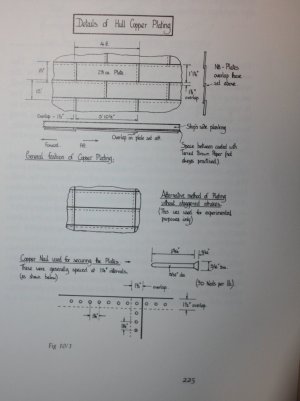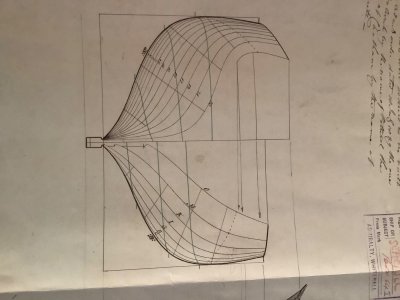"Need to place frames on the deadwood."
"Is it possible to construct the model with the frames/locations as drawn or with some intermediate, or is it essential to make all the 12.5” frames and pack them in solidly?"
"I have read that measurements from the stern frame sections intersect the deadwood (not sure I get this!) can derive the bearding line."
The usual method is to have a stem/apron - keel - keel/deadwood - sternpost as a starting unit. Where the deadwood begins the frames go from being full cross frames to being half frames that butt against the deadwood on both sides. I think that "intersect" may mean that a channel was cut into the deadwood as a socket for the heels of the frames. Something that a router or dido blade would do now? On a model, I am not sure that the difference between a simple butt and a routed channel can even be seen. An easier way would be to have the actual deadwood be lower - have it stop at the bearding line - use full cross frames all the way to where the cant frames start - or go full on stylized and use full cross frames all the way to the sternpost = no cant frames to futz with. Do the same at the apron. The cost is having to remove much more wood to get the bevel. The gap between the frames would be filled with a vertical pseudo deadwood piece of wood that is the width of the keel/deadwood. The grain would be perpendicular to the direction of actual deadwood grain - but can the difference be seen? Fake it rather than do it as far as what is deadwood in the way of the frames.
The width of the keel tapers to the stem ( the stem also has a really serious taper and one that is dynamic. By which I mean that knife edge at the figurehead is more narrow than the knife edge at the waterline, ) -
There is a similar taper to the sternpost. It is not a continuous taper. It stays unchanged until it gets sorta near to each end. I do not remember seeing a rule about where the taper begins. I would not taper the deadwood or apron with the keel. The frame heel stops when its pattern width is the full keel width. This is what the bearding line is. The long (and gets longer) taper from the bearding line down to the rabbet at the keel is adzed out of the deadwood. The actual frame stops far short of where its pattern shape shows it to be,
The floor is 12.5" wide, The half floor is 12.5" wide. They all touch. F1 is something like 11" wide. F1 butts on the half floor and then floats free in space. F3 is scarphed to F1. It starts at the same 11"(?) and tapers - which would be maddening to replicate. It is behind the topside planking anyway. F2 looks to be something like 9-10" wide. It butts on the floor timber end. It floats in space too. F4 looks to be 8-9" wide and butts on the end of F2, Also behind topside planking. This pattern is purely functional. Are you sure that you want to exactly replicate this?
I would make the frame on either side of each station line be 12.5" wide all the way and bond the two into a bend. The overlap solves the weak end grain to end grain bond problem (which is actually a non-bond). Omit the two frames in the middle. You can fit a thin piece of wood that is keel width - on top of the keel in the space between each bend. This will make for a stronger bond to the keel for the bends and it will look like you either notched the top of the keel or the heel of the bend. It will avoid any troublesome notch milling in the actual keel. Lowering the river instead of raising the bridge as it were.
Dean













